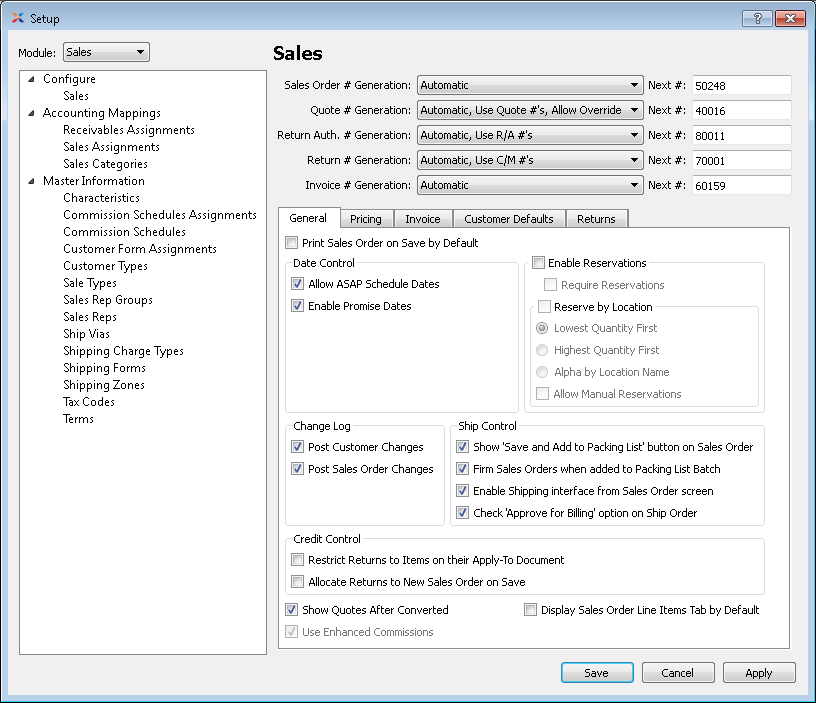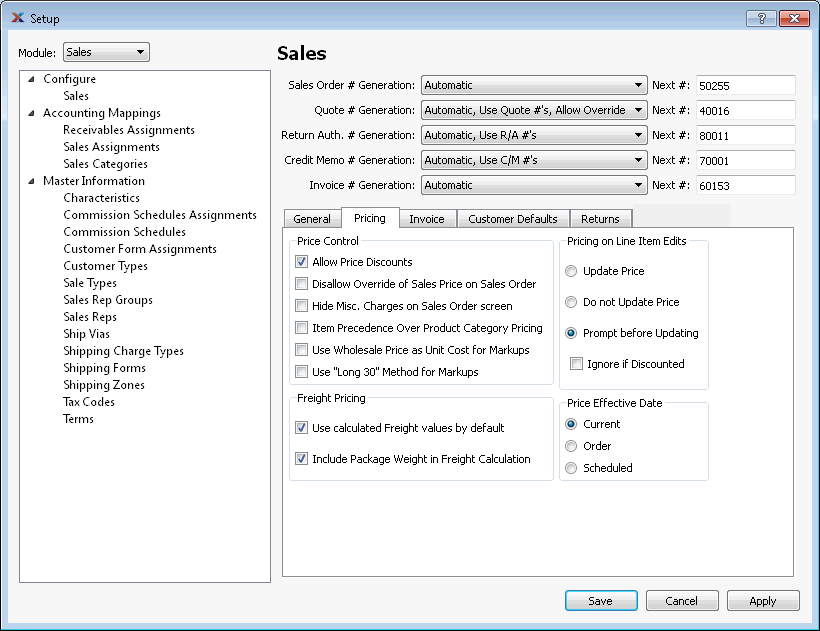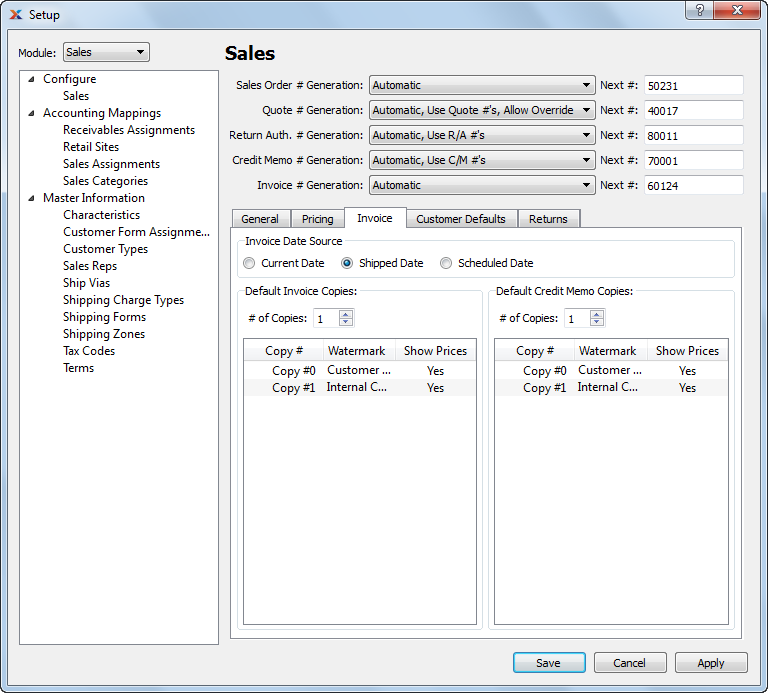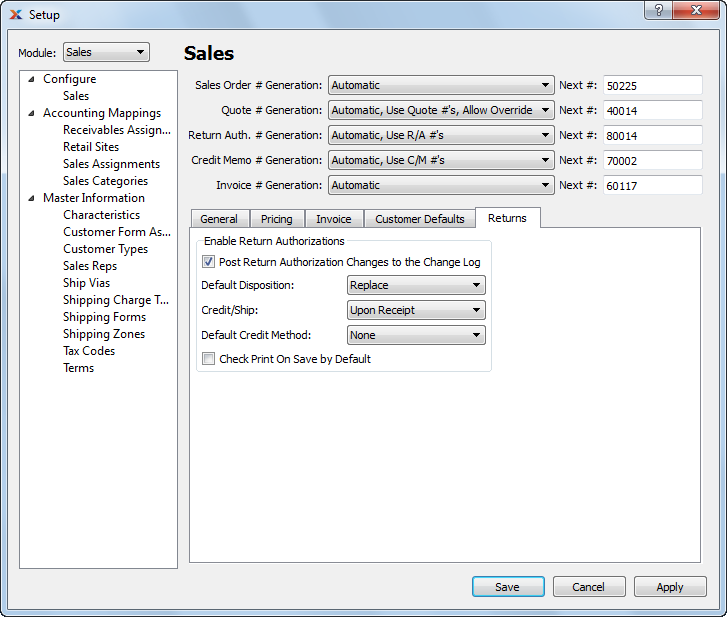
|
xTuple ERP Reference Guide |
To configure the Sales module, select the "Configure Sales" option. The following screen will appear:

When configuring the Sales module, you are presented with the following options:
Select one of the available Sales Order Number generation methods:
Sales Order Numbers must be entered manually whenever you create a new Sales Order.
Sales Order Numbers will be automatically incremented by 1 each time a new Sales Order is created. These automatically-generated numbers may not be edited. They are read-only.
Sales Order Numbers will be automatically generated and incremented, as under the "Automatic" option described above. However, this option also allows you to manually override the Sales Order Number at the time of Sales Order creation.
The next sequentially available Sales Order Number will display here. You may change the number—creating a new basis for the next Sales Order Number—by typing the new number into this field. Any changes you make here will be reflected the next time a new Sales Order is created.
Select one of the available Quote Number generation methods:
Quote Numbers must be entered manually whenever you create a new Quote.
Quote Numbers will be automatically incremented by 1 each time a new Quote is created. These automatically-generated numbers may not be edited. They are read-only.
Quote Numbers will be automatically generated and incremented, as under the "Automatic" option described above. However, this option also allows you to manually override the Quote Number at the time of Quote creation.
Quote Numbers will be automatically incremented by 1 each time a new Quote is created, using the same number generation method specified for the creation of Sales Order Numbers. These automatically-generated numbers may not be edited. They are read-only.
The next sequentially available Quote Number will display here. You may change the number—creating a new basis for the next Quote Number—by typing the new number into this field. Any changes you make here will be reflected the next time a new Quote is created.
Select one of the available Return Authorization Number generation methods:
Return Authorization Numbers must be entered manually whenever you create a new Return Authorization.
Return Authorization Numbers will be automatically incremented by 1 each time a new Return Authorization is created. These automatically-generated numbers may not be edited. They are read-only.
Return Authorization Numbers will be automatically generated and incremented, as under the "Automatic" option described above. However, this option also allows you to manually override the Return Authorization Number at the time of Return Authorization creation.
The next sequentially available Return Authorization Number will display here. You may change the number—creating a new basis for the next Return Authorization Number—by typing the new number into this field. Any changes you make here will be reflected the next time a new Return Authorization is created.
Select one of the available Return Number generation methods:
Return Numbers must be entered manually whenever you create a new Return.
Return Numbers will be automatically incremented by 1 each time you issue a new Return. These automatically-generated numbers may not be edited. They are read-only.
Return Numbers will be automatically generated and incremented, as under the "Automatic" option described above. However, this option also allows you to manually override the Return Number at the time of Return creation.
Return Numbers will be automatically incremented by 1 each time a new Return is created, using the same number generation method specified for the creation of Sales Order Numbers. These automatically-generated numbers may not be edited. They are read-only.
The next sequentially available Return Number will display here. You may change the number—creating a new basis for the next Return Number—by typing the new number into this field. Any changes you make here will be reflected the next time you issue a new Return.
Select one of the available Invoice Number generation methods:
Invoice Numbers will be automatically incremented by 1 each time a new Invoice is created. These automatically-generated numbers may not be edited. They are read-only.
Invoice Numbers will be automatically generated and incremented, as under the "Automatic" option described above. However, this option also allows you to manually override the Invoice Number at the time of Invoice creation.
The next sequentially available Invoice Number will display here. You may change the number—creating a new basis for the next Invoice Number—by typing the new number into this field. Any changes you make here will be reflected the next time you create a new Invoice.
To establish general settings for the Sales module, select the "General" tab. The following options will appear:
Select to prompt users to print Sales Orders whenever Sales Orders are saved. If selected, users will be presented with a Sales Order print screen whenever a Sales Order is saved. To bypass this feature, do not select this option.
Select from the following date control options:
Selecting this option will cause Sales Order Line Items to default to the current date if no schedule date is entered.
The allocation of available Credit Memos occurs only once—when a Sales Order is saved for the first time. Subsequent saves will not result in additional allocations.
Select to display a Promised Date field on the Sales Order Line Item screen, by default. If not selected, there will be no Promised Date field shown on that screen.
Select from the following change log options
Select to post to the Change Log any changes made to Customer masters.
Select to post to the Change Log any changes made to Sales Orders.
Select from the following credit control options:
Select if you want to restrict Credit Memo Items to their Apply-To Document. Selecting this option narrows the Credit Memo Item selection process to only those Items which appeared on the Invoice the Credit Memo is being applied to. If not selected, a sold Item master list will appear instead when selecting Credit Memo Items for Credit Memos applied to a specific Invoice. This setting has no bearing on unapplied Credit Memos.
Select to have open Credit Memos for a Customer automatically allocated to any new Sales Orders entered for that Customer. This functionality helps reduce Customer credit balances by ensuring that Customer credits are consumed when new Sales Orders are entered. Any available, open Credit Memos are eligible for allocation. The allocation of available Credit Memos occurs only once—when a Sales Order is saved for the first time. Subsequent saves will not result in additional allocations. Credit Memos which have been allocated to a Sales Order are applied at the point when the Invoice resulting from the Sales Order is posted. Once the full balance of a Credit Memo has been applied, the Credit Memo is then closed. The printed Invoice the Customer receives will indicate whether Credit Memos have been applied. In addition, the total due from the Customer will be automatically adjusted to reflect any applied credits.
Select to enable the Sales Order Reservations functionality system-wide. This feature allows for the hard allocation of quantity to Sales Orders. If not selected, the Sales Order reservation options will be hidden from view.
When checked, the quantity issued to shipping will be limited by the quantity reserved for a Sales Order.
Select to set Sales Reservations for discrete locations and lots. The hard allocation of quantity will be for particular locations and will prevent other orders from issuing reserved inventory. The Sales Order Pick List will print the reserved location to expedite inventory picking. You may choose the order of precedence for selecting locations: Lowest Quantity First, Highest Quantity First, or Alpha by Location Name.
Changing the "Reserve by Location" option from enabled to disabled will remove all location reservations.
Locations for the Item will be sorted ascending by quantity. Reservations will start with the Location with the lowest quantity and continue until the quantity required is fully reserved or there is insufficient quantity on hand.
Locations for the Item will be sorted descending by quantity. Reservations will start with the Location with the highest quantity and continue until the quantity required is fully reserved or there is insufficient quantity on hand.
Locations for the Item will be sorted ascending alphabetically by the Location Name. Reservations will start with the first Location and continue until the quantity required is fully reserved or there is insufficient quantity on hand.
If selected, this option allows a user to choose a specific Lot to be reserved for a Sales Order Item.
Select from the following ship control options:
Select if you want the SAVE AND ADD TO PACKING LIST button to always be displayed on the Sales Order header screen. If this option is not selected, the SAVE AND ADD TO PACKING LIST button will only be displayed for newly-entered Sales Orders which have not yet been saved.
Select to make Sales Order Line Items firm when the Sales Order they are on is added to the Packing List batch.
Select to enable the performance of limited Shipping functionality from the Sales Order header. If selected, users will be able to issue Stock to Shipping and also return Stock from Shipping directly from the Sales Order header. If not selected, these Shipping options will not be available on the Sales Order header.
Select if you want the "Select for Billing" option to be selected by default whenever you ship Sales Order Line Items. Selecting this option reduces steps in the billing process. Specifically, if an Order is selected for billing when it is shipped, you do not then have to take the extra step of independently selecting the Order for billing. This can save time and also ensure your shipped Orders are selected for billing at the time of shipment.
Select if you want to be able to view historical Quotes after they have been converted to Sales Orders. If you don't select this option, converted Quote information will not be saved.
Select to display the Sales Order window with the Line Items tab displayed initially.
To establish Customer pricing options, select the "Pricing" tab. The following screen will appear:

When establishing Customer pricing options, you are presented with the following options:
Select from the following price control options:
Check this option to allow pricing discounts for select customers. This option instructs the system to verify whether any Pricing Discounts have been established for a Customer, prior to calculating the Line Item Price for of an Item within a Sales Order. If this option is unchecked, then the system will apply the full List Price for an Item within a Sales Order.
Select to prevent all users from overriding the Sales Price when entering Sales Order Line Items. This is a system-wide setting, affecting all users. Do not select this option if you want to selectively prevent users from overriding Sales Prices. Individual users may be granted the ability to override Sales Prices, use the Sales module's OverridePrice privilege.
Select to hide all fields related to Miscellaneous Charges on the Sales Order Line Item tab. If your site does not use Misc. Charges when entering Sales Orders, it may make sense to hide this functionality to avoid confusion.
If selected, Item specific Price Schedule pricing takes precedence over Product Category pricing. Leave unchecked if the lowest overall price should be selected.
If selected, the Item wholesale price is used as basis for markup pricing. Leave unchecked to use the standard or average cost against the Item or Item Site cost.
Select to calculate markup percentage up to 50% as unit cost divided by (1 / markup). The price will otherwise be calculated as the sum of the unit cost and (unit cost * markup).
Specify how you want freight charges to be handled when shipping Orders and Returns:
If selected, Items issued to Shipping will be checked against Pricing Schedules to determine the actual freight for a given Shipment based on shipping quantities and weight rather than assuming all freight should be billed. If not selected, the freight amount on an Order or Return will be billed on every Shipment.
Select to include package weight in the freight calculations. If not selected, package weight will be excluded.
Select one of the following as your preferred response when users change Sales Order Line Item quantities:
The Sales Order Line Item pricing options apply only when editing Line Item quantity.
If selected, the system will automatically update the Net Unit Price for the Line Item, adjusting to accommodate the newly-entered quantity.
If selected, the Net Unit Price will not be changed when Line Item quantity is changed on EDIT—and users will not be prompted to consider changing the Price.
If selected, the system will ask users if they want to update the Net Unit Price (YES/NO). If they answer "YES" because they do want to update the Price, then they will have to manually make the Price adjustment.
Select if you want Price update warnings to be ignored when Line Items being edited are already discounted. Also, if Sales Order header changes cause Prices to be updated, any discounted Line Items will not be updated.
Specify one of the following options for when Item Prices should be effective as of:
Select if you want Item Prices to be effective as of the current date.
Select if you want Item Prices to be effective as of the Order date.
Select if you want Item Prices to be effective as of the scheduled date.
To establish Invoice and Credit Memo settings, select the "Invoice" tab. The following screen will appear:

When establishing Invoice and Credit Memo settings, you are presented with the following options:
Select one of the following Invoice date options:
If selected, the Invoice date on the Invoice header will be the same date as the Sales order date.
If selected, the Invoice date on the Invoice header will be the same date as the Sales Order ship date.
If selected, the Invoice date on the Invoice header will be the same date as the Sales Order scheduled date.
Indicate how you want invoice copies to print.
Indicate the number of copies you want to print. Information about the specified copies will display below.
Indicate how you want credit memo copies to print.
Indicate the number of copies you want to print. Information about the specified copies will display below.
To establish default settings to be used whenever new Customers are entered, select the "Customer Defaults" tab. The following screen will appear:

When creating new Customer records, it can be useful to have a core set of default values already pre-defined. All these values can be changed when you are creating new Customers. However, they provide you with a default starting point. The following settings you define here will be present whenever you create a new Customer:
Specify a default Customer Type to be used whenever new Customers are created.
Specify a default Sales Representative to be used whenever new Customers are created.
Specify a default Ship Via to be used whenever new Customers are created.
Specify a default Shipping Form to be used whenever new Customers are created.
Specify a default Shipping Charge to be used whenever new Customers are created.
Specify a preferred selling Site to be used whenever new Customers are created.
Specify the default billing Terms to be used whenever new Customers are created.
Specify a default procedure for handling cash receipts from Customers. This notation is informational only.
Select to indicate you want to apply cash receipts to the Customer's current balance due.
Select to indicate you want to apply cash receipts to specific Customer open items.
Select to indicate Customers accept partial shipments by default.
Select to indicate Customers accept backorders by default.
Select to indicate Customers allow free-form Ship-To's by default. This default appears on the Customer master.
Specify the default credit limit to be used for all Customers.
Specify the default credit rating to be used for all Customers.
To define your system's Return Authorization configuration, select the "Return" tab. The following screen will appear:

Returns Configuration Options
When configuring Return Authorization settings, you are presented with the following options:
Select to enable the system's Return Authorizations capability. If not selected, users will be prevented from performing any tasks related to Return Authorizations—and related functionality will be hidden from view. For systems where Return Authorizations are enabled, this option will be hidden.
Select to record changes made to Return Authorizations in the Return Authorization change log. If not selected, the Return Authorization changelog will not contain change information.
Specify one of the following default methods for handling Return Authorizations:
Select if, by default, you want to issue credit to Customers for authorized Line Items and quantities. No return is required or expected. Return Authorization Line Items will close when an associated Credit Memo is posted.
Select if, by default, you want to authorize returns from Customers. Return Authorization Items will close when an associated Credit Memo is posted, or when all Items on a line have been returned, whichever comes last.
Select if, by default, you want to replace Items returned by Customers. Authorized quantities will be added as additional order quantity to an associated Sales Order line, which in turn should be reopened if closed. Return Authorization Items will close when all Items on the line have been returned or all authorized Items on the line have been shipped, whichever comes last. No money should be involved when invoicing replacement Items.
Select if, by default, you want to repair or service Items returned by Customers. Service or repair items will first be received by a Return Authorization. Then a new Sales Order with linked Work Order(s) will be created to track work and shipping on the repair or service. The new Sales Order will be on RMA Hold until Items have been received by the Return Authorization.
Select if, by default, you want to authorize the substitution of Items returned by Customers. Under this option, when an original Sales Order is imported into the Return Authorization, the Return Authorization Line Items will default to the Return disposition. Any new Line Items added beyond the original ones will have a default disposition of Ship.
Specify the default timetable for Customer credits and/or returns:
Select to issue credit or send returns to Customers immediately by default.
Select to issue credit or send returns to Customers only after you have received returned goods from them by default.
Specify one of the following default credit method options:
Select if, by default, you do not issue credit for Customer returns.
Select if, by default, you credit Customer returns with a Credit Memo to the Customer's account. This option will result in the automatic creation of a sales Credit Memo.
Select if, by default, you credit Customer returns by sending them a payment. This option will create a Credit Memo, then a Misc. Payment that applies to the Credit Memo.
Select if, by default, you credit Customer returns with a refund on their Credit Card.
Select if you want the "Print on Save" option to always be enabled when creating new Return Authorizations.